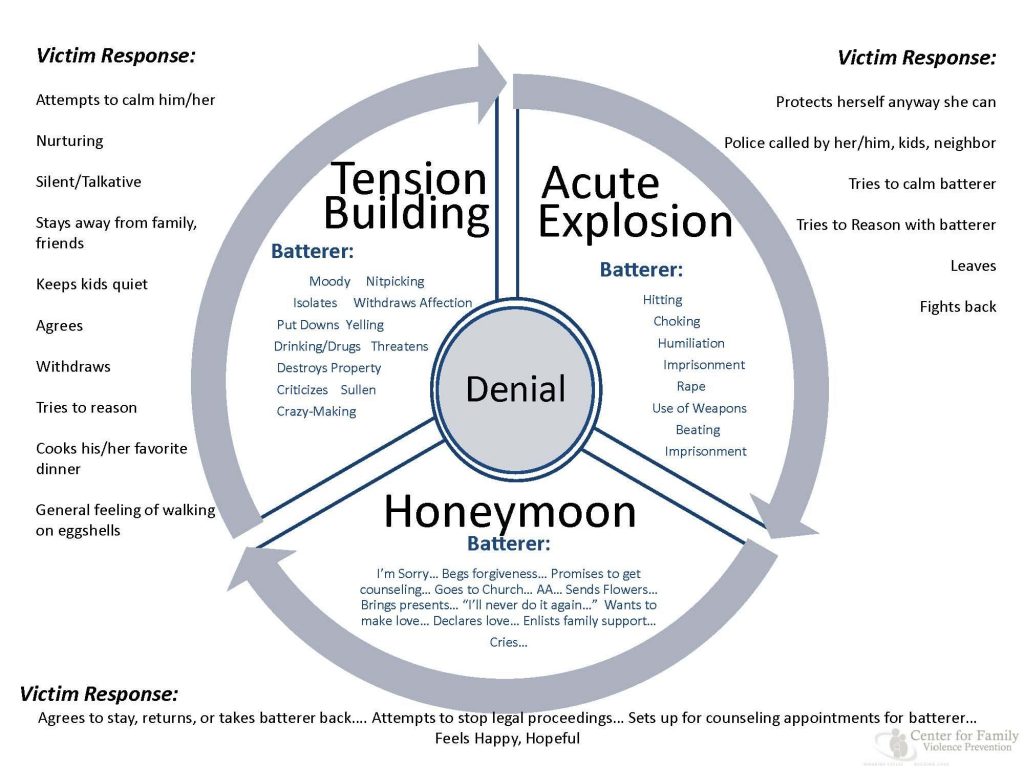The Cycle of Abuse

The “Honeymoon” Phase: How the relationship begins – Phase One
This is the person you fall in love with, and, like it or not, what you will miss if you end the relationship. It might not be flowers and candy; it might be romantic walks, long phone calls, feeling as if you are soul mates. It might be discovering how much you seem to have in common, or feeling that the person knows you better than anyone you have ever met. You can’t imagine this person doing anything mean or violent – after all, how could someone who loves you so much possibly do something to hurt you?
The Tension Phase: Walking on Eggshells – Phase Two
The things might be “little things” that you dismiss as unimportant, but the overall impact between you and your partner gets bigger and bigger. As the abusive partner tries to control you, there is a sense that you can avoid getting them really mad if you just do what they want you to do. After a while, though, no matter what you do will be good enough, and you move into Phase 3.
The Explosion: The shortest, but most dangerous phase – Phase Three
The first explosion might just be yelling and calling you names, but explosions can be a threat to hurt you, throwing an object across the room, threatening to break up if you don’t agree, pushing you in anger, or more severe expressions of physical violence. Some people have been kicked, cut with a knife, beat up, choked, slapped, burned, and scratched. They have had their arm held so tightly it bruised, had their fingers bent, and been dumped out of car. The explosion breaks the tension that has built up in Phase 2, and doesn’t last long. The violence expressed does, and will, get worse over time. Even if it is “only” verbal or emotional, chances are high that it will eventually become physical.
The Apology: Phase One Begins Again
This is the person you fell in love with, but somehow, even better. Of course, there are the promises that this will never happen again, and there will probably be gifts, a dinner out, a movie, or something that shows you how much that person loves you, and how sorry they are. They seem even sweeter in comparison to the explosion that just happened, and you may be confused by how you could have, only moments ago, been so scared and hurt. Also, you have just shared a very emotional experience, and it’s normal after “getting through” something together to feel even closer than before. This is the “hook” that keeps people stuck in the Cycle of Violence. What you need to remember is that no matter how close you may feel, if it is one part of this three-part cycle, it’s not fair to you.
And the whole cycle continues again, and again, until you make the decision to leave.
One reason that it gets harder to leave as time goes on is that the tension and explosion slowly but surely depletes your self-esteem. You are more and more likely to believe that your violent partner’s behavior is your fault. That is why it is so important to learn to recognize the Cycle, so that you can get out early in the relationship.
If you recognize yourself in this Cycle, get help from someone you trust.
Give us a call, anytime, on our 24-hour crisis line at (608) 325 7711. You don’t have to give us your name. We can give you more information to help you decide, or we can help you plan how to safely end the relationship.
Information by Community Beyond Violence, http://cbv.org/domestic-violence-victim-services/
